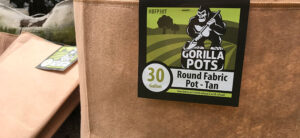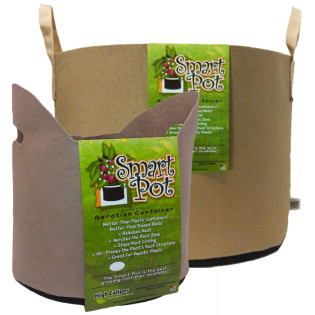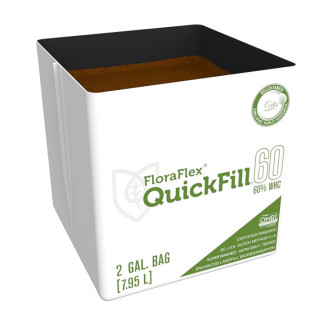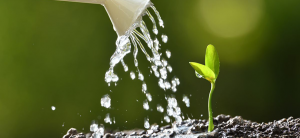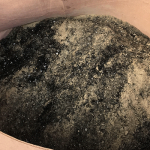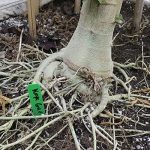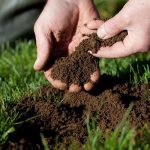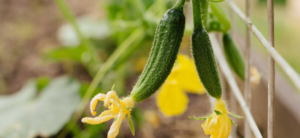
If you plan on growing huge, potent plants, whether it be indoors or outdoors, you need the best garden pots. If you think all garden pots are the same, think again!
There is a specific garden pot or container for every growing method, and each one has an ideal growing medium to accompany it.
By the end of this, you will know which pot you should be growing in.
Before we go crazy educating you on all the different types of garden pots, let's start with a lesson on root conditions.
You need to understand the importance of root pruning and air pruning to prevent root circles, how to improve aeration and drainage, and more.
Jump to: Net Pots | Fabric Pots | Plastic Pots | Air-Pots | Fabric planters | Peat Pots | Plastic Grow Bags | Saucers | Buckets|
Root Circles, Root Lock & Root Bound Plants
Root circles occur when roots become locked or bound. Think about how your root system develops. It grows down into the pot, but also laterally, with sideways branching.
Eventually, your roots run into the wall of your garden pot or container. At that point, they will turn the other way to continue growing.
As your root system continues to grow, it starts to cross back over itself, creating root circles, and eventually, becoming root bound.
Plants that have root circles can be transplanted to a larger pot but roots are not as efficient at expanding out into the new, fresh grow medium.
If root circling is allowed to continue, plants become root locked or root bound. This is where roots become tangled and intertwined to the point that they choke.
Plants that experience this show symptoms of under-watering, and leaves begin to yellow.
Some root bound plants may continue to grow leaves but may never begin to flower.
All plants are different and its important to know a little bit about your plant's genetics.
Some plants only thrive under root bound conditions such as:

- Peace Lily
- Spider Plant
- African violets
- Aloe
- Umbrella Tree
- Ficus
- Agapanthus
- Asparagus fern
- Spider Lily
- Christmas cactus
- Jade Plant
- Snake Plant
- Boston Fern
How To Remedy Root Lock & Root Bound Plants

Do you see signs that your plants are root bound or locked? You need to act fast, or you may develop root rot.
Transplant them into a larger pot to allow more room for roots to grow.
If the plant is badly root bound, you may need to flex the pot in order to get it out, or in severe cases, even break the pot to extract it.
The plant may need to have roots pruned in order to free them from the root ball. Pruning roots is hard on the plant, but must be done in order to get the plant growing again.
The plant may be stunted for some time before it begins to grow again and flower. Give it time and allow your plant to begin forming new roots and existing roots to expand out into the new grow medium.
Which pots are best for plant root health?
As you shop for garden pots, you should consider which ones are best for your plants.
Plastic pots are a tried and true way to grow your plants, but they are slightly outdated with the emergence of fabric pots, air-pots, and others.
Fabric pots are simply the best for outdoor growing in particular because they air-prune your roots and lower your chance of root lock.
Air-pots are also a great choice, as they feature holes throughout the entire pot which allow for tons of aeration, thus air pruning the roots as they get close to the walls.
But, the best garden pot is not one size fits all. We'll cover each pot, and give you detailed information on who should use it, and how to use it.
The Best Garden Pots For Indoor and Outdoor Growing
We are going to cover every type of garden pot or grow container there is, and explain what type of system or grow method you should use.
We'll also cover the best grow media to use for each one, so by the end of this section, you'll know exactly how to start your grow.
Let's start with hydroponic pots, also known as net pots.
Net Pots (Hydroponic Pots)

Are you growing in a hydroponic system? If so, you will either use net pots or no pot at all!
Net pots are ideal for deep water culture, nutrient film, aeroponics, and ebb & flow hydroponic systems.
They support seedlings and cuttings well in propagation systems. Their open nature promotes drainage and aeration of roots, which is crucial in hydroponic systems.
This also allows roots to grow through the net pot to reach the nutrient solution easier.
Net pots come in square and round shapes ranging in size from 2” to 10” in diameter.
Because of their strong plastic construction, they can be reused from growing cycle to cycle after being properly cleaned and sterilized.
Best for: Hydroponic systems
Best grow media: Clay Pebbles or Grow Stones, Rockwool, Perlite
Fabric Pots

As we mentioned earlier, fabric pots are one of our favorites.
With fabric pots, the likelihood of plants becoming root bound is rare.
These garden pots are quickly becoming a favorite in the gardening and horticulture worlds.
Fabric pots range in size from 1 gallon up to 500 gallons, and come in black, camo, and tan colors.
Some larger pots have handles, making moving plants a breeze. The breathable fabric allows for great drainage and aeration of roots.
When the roots extend to the wall of fabric, they are exposed to air. Because of this, the roots will be air pruned and start branching off in other directions instead of circling. This is why it is very uncommon for plants to become root bound in fabric pots.
The non-rigid form of these garden pots allows them to conform to whatever terrain they are placed in, making them very stable on uneven surfaces.
They also tend to keep roots cooler in summer and warmer in winter (especially if you go with a tan one, as these deflect the most heat).
At the end of growing cycles, fabric pots can be emptied and allowed to dry for a few days.
Once they are dry, the inner walls and surfaces can be scraped clean and pots can be stored flat to conserve on space. Smart Pots are machine washable and feature ultra-violet stitching to resist fading.
The best fabric pots - Gorilla Pots
If you are sold on fabric pots for your garden, great choice! But there are tons of fabric pots, and they all look the same...does it matter which one you go with?
We love Gorilla Pots and stand by these fabric containers as the best in the business.
They are incredibly affordable and made from high-quality material. This means they will last years and years of successful growing!
Best for: Soil, soilless, and drip systems
Best grow media: Soil, soilless, coco, clay pebbles, Growstones, Rockwool
Plastic Pots

Looking for a tried-and-true pot to get the job done? Look no further.
Injection molded plastic pots have been the standard go-to for years.
Traditional garden pots feature strong, sturdy sides with drains at the bottom to allow excess water runoff. They can be easily stacked and are resistant to tipping over in wind.
Some plastic pots can be used with hydroponic systems and all can be used with soil or soilless grow media in a traditional garden. These are easily modified for DIY projects and make great starting pots.
Always choose a plastic pot that is larger than your initial plant needs. Make sure to transplant your plant as soon as roots reach the outer edge of the pot, ensuring continued healthy growth.
If you are growing in a plastic pot, you should make sure you have a saucer to match.
Best for: Soil, soilless, drip systems, *hydroponics
Best grow media: Soil, soilless, Coco, *clay pebbles, *Growstones, *Rockwool, *perlite
*some can be used in hydroponic systems
Air-Pots

These are as advanced as a garden pot can get.
Air-pots are a relatively new style of plant containers. Since they are hollow, they are very light and provide unparalleled aeration.
Just look at the design of these, and you can see how much aeration your root zone will get!
Air pots feature concentric rings of cones pointing both outward and inward.
The inward-facing cones help to prevent root circles by disrupting roots near the walls of the container. The outer cones allow superb aeration and air pruning of roots.
The bottom of these pots are offset from the base to allow for more aeration, while insulating roots from cold or hot surfaces. This design efficiency can lead to an almost 15% increase in nutrient uptake.
Air-pot volume is measured in gallon equivalency. Air-pots can even be used in hydroponic systems
Best for: Soil, soilless, drip systems, hydroponics
Best grow media: Soil, soilless, Coco, clay pebbles, Rockwool
Plastic Grow Bags

These are an excellent low-cost alternative to traditional plastic pots used by greenhouse growers.
Plastic grow bags are specially designed to last longer than any other grow bag on the market.
They have drainage holes in the bottom, and can be used with just about any grow media.
Plastic grow bags are excellent for bedding plants, and are widely used in greenhouses.
Plastic grow bags are more flexible than plastic pots allowing them to more easily flex to get plants out during transplanting.
Best for: Soil, soilless, drip systems
Best grow media: Soil, soilless, coco
Saucers

Planting pots are placed inside of saucers to catch excess water and nutrient runoff from plants. Saucers come in a variety of sizes and colors to fit just about any pot and style.
These are a great way to prevent water from spilling inside of your grow area and protect floors and carpeted areas when used indoors.
Saucers provide a strong, sturdy base to prevent tipping and can be washed and reused for multiple growing cycles.
Using saucers makes checking water a breeze. The ribbed surfaces inside prevent pots from sticking to them while keeping plants elevated from excess water.
It is important to check the pH of your nutrient runoff, and using a saucer collects the runoff to make this simple.
You can either house each plant within a saucer, or use a large tray to house many plants. Either way, make sure you are doing something about your runoff.
Best for: Protecting floors and other grow areas from watering overflow.
Buckets & Lids

I know you may be wondering what standard buckets and lids have to do with gardening.
But these are perfect for containing and transporting both liquids and solids, and a number of other gardening purposes.
You can create your own DIY hydroponic, aeroponic, or drip system with these. Many feature a steel carrying handle and an ergonomic grip.
Growers can fasten lids on a bucket to create a watertight seal. This will prevent contaminants from entering the bucket and preserving what is inside.
Flip them over to create an instant seat to ease legs and backs and two with a board between to create an impromptu shelf or bench. Your garden will not be complete without at least a few of these.
Best for: Just about anything!
What size pot do I need for my plant?
Think about the final size of your plant. How big do you want it to grow?
First, its important to understand you will likely not be using one pot throughout the entirety of your grow. Accommodating your plant's growth with different pot sizes is crucial to root health.
A general guideline is you will need a 2 gallon pot for every 12" in plant height. Remember that every plant is different, and some grow very short and bushy, so this won't always hold true.
Transplanting for accelerated growth

We advise you to use multiple pots throughout the growing cycle, and to transplant as growth occurs.
Start very small, such as a 1 gallon pot or a red solo cup with drainage holes.
Starting with a smaller pot prevents the likelihood of over watering, and will provide better aeration for the tiny root mass at first.
As your clone or seedlings root system starts to develop, the time will come to transplant it from the original 1 gallon pot into a larger container. This will allow the roots to expand even further, and accelerate plant growth.
When transplanting, pay close attention to not disrupting the root zone. This can cause a stunt in growth. Have your new pot ready, and filled partially with your growing medium. If you are transplanting indoors, be prepared for a mess.
Turn the potted plant upside down, and support the stalk with your hand. Gently shake the pot with the other hand, and the plant should come free easily, assuming it is not root bound.
Then, place the plant into the new container, and fill the rest of the pot with growing medium.
If you used a root plug for your clone or seedling, this process is even easier, since you can simply plant the root cube within the garden pot.
Check out our complete guide on how to transplant a plant for an in depth look into this process.
Using one garden pot for the entire plant life cycle

If you are growing an auto-flowering variety, or simply don't have the time to transplant, it is possible to grow in one container. You will probably start with a large 8-10 gallon container.
Watering will need to occur in small doses. This ensures the roots do not drown, but keeps them continuously moist.
Watch for the first inch of soil to become dry, and then water again, in a small circle around the plant.
As the plant grows into this container, you can start to water more regularly.
Growth will start much slower in an over-sized pot, but skipping transplanting will make your life easier and reduce the chance of mistakes. If you are a new grower, you may be better off starting with one pot.





